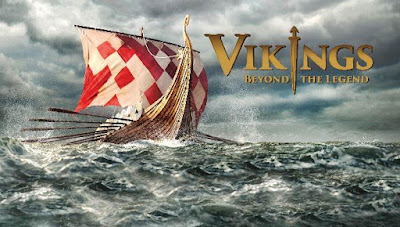On Saturday this week I listened to Kristiane Strætkvern, conservator of the Danish National Museum, telling the story of how a Viking
ship was unearthed in Roskilde fjord, Denmark, in 1996 and twenty years later made its
way to Ohio to be a major focal point of the recent exhibit at the Cincinnati
Museum Center.
In 1996-1997 the Viking Ship Museum in Roskilde was
expanding. During the renovation process the remains of nine Viking ships were
unearthed. Through investigation over several years, the ships were determined
to have been constructed during the period 1009-1032 AD. Roskilde 6 was the
sixth one to be unearthed; restoration of this long ship started in 2009. With
a series of excellent and detailed slides, Kristiane explained the process of
conserving the waterlogged remains of the ship, using polyethylene glycol (PEG)
to remove the excess water and then freeze drying—it took 3 ½ years to complete
the freeze drying!
When the restoration began in 2009 it was not envisioned
that the ship would be exhibited outside Denmark, but by 2013, it was decided
that exhibition would start first in Copenhagen but then go on to London and
then Berlin. This complicated the conservation process tremendously—in addition
to planning for assembling the ship, plans had to be made for dissembling it,
packing it, and transporting it. Denmark, unlike some other countries, does
excavation and reconstruction piece-by-piece, rather than assembling the object
as a whole in one piece. The careful marking of each piece was crucial in
moving the exhibit from place to place. All three exhibits were successful,
gathering nearly 200,000 visitors in each of the three museums.
In 2016, through cooperation with a museum exhibition
company, the Roskilde 6 ship was matched with the Cincinnati Museum Center, and
now the exhibit had to be transported out of Europe for the first time. It came
from Copenhagen to New York by ship; from there parts were re-packed and sent
by air, while other parts came by truck. Kristiane came to Cincinnati to direct
the assembly of Roskilde 6, and she returned for its disassembly, which is
scheduled to take ten days. (A YouTube video shows its assembly in Cincinnati https://www.youtube.com/watch?v=CFMB-IBFOk8&feature=youtu.be.) Roskilde
6 is “almost certainly” going to Minneapolis after its Cincinnati run, and it
is hoped that it will find a temporary exhibition spot on the west coast and on
the east coast before making its way back to Denmark, where it will become part
of the permanent collection of the National Museum of Denmark.
At 122 feet, Roskilde 6 is the longest Viking ship yet discovered,
and required 100 men as crew. It was definitely used as a warship and was built
after 1025, probably in Oslo and shows signs of being repaired at a later date,
also in Norway, before finding its nearly 1,000-year resting place in Roskilde fjord.
It was operational at a time when King Knud of Denmark was fighting against
King Olav of Norway, but it is not known who commissioned its construction.
More links:
Roskilde 6, from the
Viking History Museum in Roskilde
Longest known Viking
ship goes on display at British Museum http://www.historyextra.com/news/longest-known-viking-ship-Roskilde-6-goes-display-exhibition-british-museum
Rebirth of the Viking
warship that may have helped Canute conquer the seas
It is still somewhat amazing to me that the first appearance of this restored ship outside of Europe would be in Cincinnati. We went to the exhibit with friends last month and I was amazed at the information in the entire exhibit--the Viking ship was only a part of the excellent content. It closed today, and although the exhibit was excellent, there was virtually no representation of this curation online or in book form, and that is a terrible loss.

